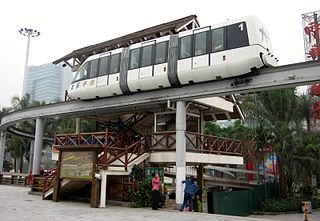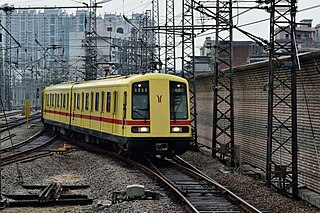
The Tea Horse Road or chamadao, now generally referred to as the Ancient Tea Horse Road or chamagudao was a network of caravan paths winding through the mountains of Sichuan, Yunnan and Tibet in Southwest China. This was also a tea trade route. It is also sometimes referred to as the Southern Silk Road or Southwest Silk Road.
Guizhou Daily or Guizhou Ribao is the largest provincial newspaper by readership of the southern Chinese province of Guizhou. It is the official newspaper of the Guizhou Provincial Committee of the Chinese Communist Party (中共贵州省委). The paper was launched on November 28, 1949 under the name of Xinqian Daily (新黔日报), and was renamed to its present name on 1 January 1957.

The Happy Line is a monorail line in central Shenzhen. The line is a loop and has seven stations, including stops at Splendid China, Happy Valley, Window of the World, and China Folk Culture Village.
Maguan Town is a rural town in Puding County, Guizhou, China. As of the 2010 census it had a population of 44,596 and an area of 115.07-square-kilometre (44.43 sq mi).

Line 1 of the Guangzhou Metro runs from Xilang to Guangzhou East Railway Station. Apart from Kengkou and Xilang, all stations in Line 1 are underground. The first section, from Xilang to Huangsha, opened on 28 June 1997, making Guangzhou the fourth city in mainland China to have a metro system. Construction took a total of 66 months. The total investment is 12.2616 billion yuan with an average cost per kilometer of 662.9 million yuan. The full line started operation on 28 June 1999. Line 1 is coloured yellow.

Jinhua railway station, formerly Jinhua West railway station, is a railway station on the Shanghai-Kunming railway and the Hangchangkun Passenger Railway located in Wucheng District, Jinhua, Zhejiang, People's Republic of China.
The 2012 Guizhou Renhe season is Guizhou Renhe's 11th consecutive season in the top division of Chinese football. They also competed in the Chinese FA Cup that year, making it to the final of that competition.
Guiyang–Guangzhou high-speed railway, also known as the Guiguang HSR, is a high-speed railway line in southern China between Guiyang in Guizhou Province and Guangzhou in Guangdong Province. The railway is dedicated to high speed passenger rail service. The line is 856 km (532 mi) in length and can carry trains at speeds of up to 250 km/h (155 mph). The line was built from 2008 to 2014 and opened on December 26, 2014.

Several cities in China had tram systems during the 20th century; however, by the end of the century, only Dalian and Changchun remained extant. However the 21st century has seen a resurgence in tram transport systems as China attempts to combat with urban traffic congestion and pollution.

Changsha–Kunming high-speed railway is a China Railway High-speed line connecting Changsha and Kunming, respectively the provincial capitals of Hunan and Yunnan. It is the western end of a larger rail project, the Shanghai–Kunming high-speed railway, which is one of the Ministry of Railways's strategic four east–west high-speed railways, and an integral part of the long-term railway network plan.

Line 10 of the Chengdu Metro runs from Taipingyuan in Wuhou to Xinping in Xinjin. Currently, the line is 37.972 km (23.6 mi) long. In 2024, the line will be 43.9 km long with the 5.9 km northeastern extension to People's Park.
Pu Bo is a former Chinese politician who served as Vice Governor of Guizhou. He was dismissed from his position in May 2018 and placed under investigation by the Central Commission for Discipline Inspection and the National Supervisory Commission.

China Railways 25G rolling stock, or China Railways 25 improved rolling stock is a series of passenger carriages built in China. The carriages run services in mainland China, and on the Trans-siberian railway for international services to Moscow. They are also exported to Mombasa–Nairobi Standard Gauge Railway, Ethio-Djjbouti railways and Guinea railways, and also to be exported to Swedish state railways and Uganda Standard Gauge railways.

On 7 July 2020, a local bus in Anshun, Guizhou, in southwest China, made a sharp turn and crashed into the Hongshan Reservoir in Xixiu District. At least 21 people died and 16 others were injured. Among the passengers on the bus were candidates for the Gaokao examination.
Yinzhen Subdistrict is a subdistrict in Daozhen Gelao and Miao Autonomous County, Guizhou, China.









